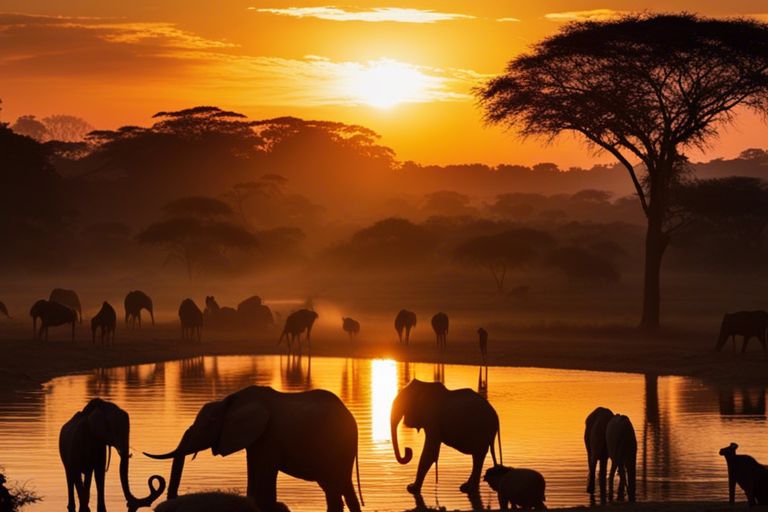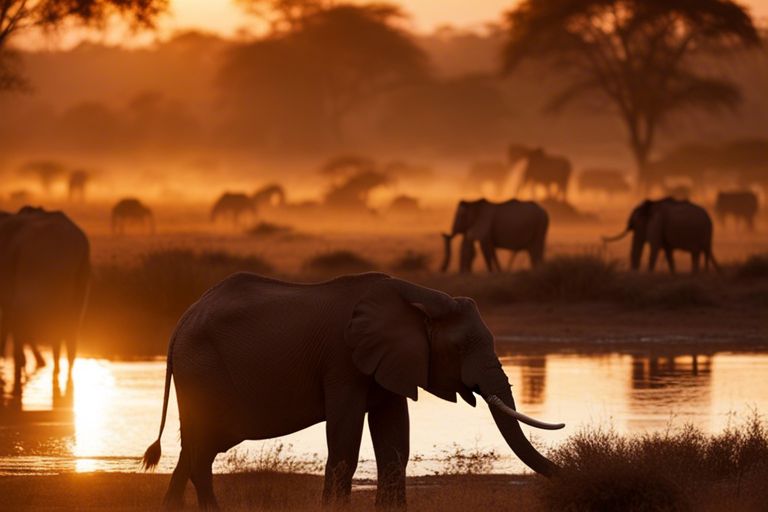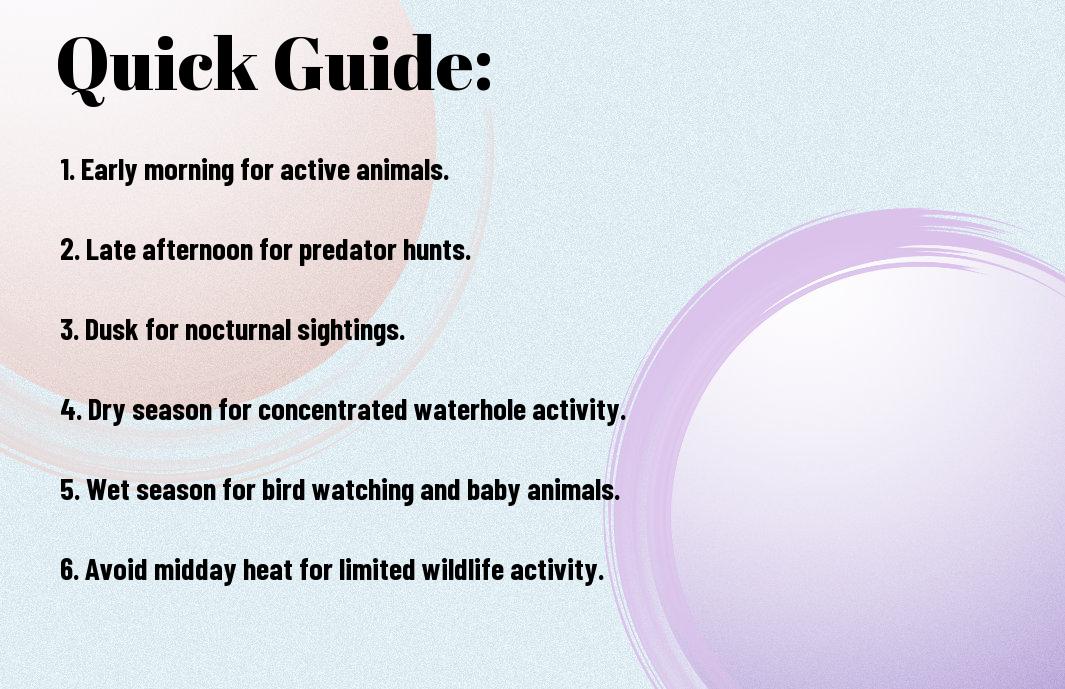Over the vast plains and dense forests of Africa, a diverse array of wildlife roams freely, offering unparalleled opportunities for unforgettable safari experiences. Knowing the best time to visit different regions of Africa can greatly enhance your chances of spotting iconic species in their natural habitats. In this guide, we will explore the optimal times to witness Africa’s breathtaking wildlife spectacles and the seasonal wonders that each month brings to this mesmerizing continent.

Key Takeaways:
- Best Time: The best time to see wildlife in Africa is during the dry season, typically from June to October.
- Migration: To witness the Great Migration in East Africa, visit between July and September when millions of wildebeest and zebras move across the plains.
- Bird Watching: For bird watching enthusiasts, the best time is during the wet season when migrant birds are present from November to April.
- Game Drives: Early mornings and late afternoons are the ideal times for game drives as animals are most active during these times.
- Weather: Consider the weather conditions when planning a wildlife safari, as rainy seasons may make spotting wildlife more challenging.
- Less Crowds: The shoulder seasons of April to June and November to early December offer fewer crowds, making it a more intimate wildlife viewing experience.
- Local Knowledge: Utilize local guides and experts who are familiar with the area and wildlife habits to enhance your wildlife viewing experience.
Understanding African Wildlife Migration Patterns
The Great Migration: When and Where
The Great Migration, often considered one of the most incredible wildlife spectacles on Earth, occurs in East Africa, primarily between Tanzania and Kenya. It involves millions of wildebeest, zebras, and other herbivores traveling in search of food and water. The migration typically takes place from July to October, as the herds move from the Serengeti in Tanzania to the Maasai Mara in Kenya.
Other Migration Patterns Across Africa
Migration is a common phenomenon among various wildlife species across the African continent. From the annual movement of elephants in Botswana in search of water sources to the trek of humpback whales along the East African coast, there are numerous migration patterns to witness throughout the year.
Great herds of elephants can be observed in Botswana as they traverse vast distances between the Chobe River and the Okavango Delta. The sight of these majestic creatures on the move is a testament to the natural rhythms and instincts that drive these impressive animals.
Types of Wildlife to See in Africa
Assuming you’re planning a wildlife safari in Africa, it’s vital to know the types of animals you can expect to see during your adventure. Africa is home to a diverse range of wildlife, from the iconic Big Five to a variety of antelopes, predators, and primates.
| The Big Five | Antelopes, Gazelles, and Other Grazing Animals |
| Predators: Cheetahs, Hyenas, and Wild Dogs | Primates: Chimpanzees, Gorillas, and Monkeys |
The Big Five: Lion, Elephant, Buffalo, Leopard, and Rhinoceros
With its prestigious title, the Big Five represents some of the most sought-after animals to spot in Africa. Lions, elephants, buffalos, leopards, and rhinoceroses are known for their strength, majesty, and elusiveness. These animals hold a special place in the hearts of safari-goers and capturing sightings of all five is considered a badge of honor among wildlife enthusiasts.
Any visit to Africa wouldn’t be complete without catching a glimpse of these magnificent creatures in their natural habitat.
Antelopes, Gazelles, and Other Grazing Animals
Leopard, impala, eland, and wildebeest are just a few examples of the diverse range of antelopes, gazelles, and other grazing animals that roam the African savannah. These herbivores play a crucial role in the food chain and can be spotted in large numbers grazing peacefully across the vast plains of Africa.
Predators: Cheetahs, Hyenas, and Wild Dogs
Wildlife enthusiasts are always thrilled to encounter predators like cheetahs, hyenas, and wild dogs during their safari. These carnivores are known for their hunting prowess and pack behavior, making for exciting game viewing opportunities. Watching these predators in action offers a glimpse into the raw and untamed side of the African wilderness.
The thrill of witnessing these predators in their natural element is an experience that will stay with you long after your safari ends.
Primates: Chimpanzees, Gorillas, and Monkeys
Predators aren’t the only fascinating animals to observe in Africa – primates like chimpanzees, gorillas, and various monkey species also call the continent home. These intelligent creatures exhibit complex social behaviors and interactions, making them a captivating subject for wildlife enthusiasts.
A visit to Africa’s lush rainforests or mountainous regions offers the opportunity to commence on a memorable primate trekking experience, where you can observe these incredible animals up close in their natural habitat.
Factors Affecting Wildlife Sightings
All wildlife enthusiasts dream of experiencing the magic of seeing Africa’s majestic animals in their natural habitat. However, there are various factors that can affect the likelihood of wildlife sightings. Understanding these factors can help maximize your chances of witnessing these incredible creatures in action.
Weather and Climate: Rainy vs. Dry Seasons
Some of the most significant factors influencing wildlife sightings in Africa are the weather and climate conditions. The distinction between rainy and dry seasons plays a crucial role in determining the movement and behavior of animals. During the dry season, animals gather around water sources, making it easier to spot wildlife congregating around these areas. In contrast, the rainy season provides lush vegetation and new sources of water, dispersing animals across a wider area, which can make sightings more challenging.
This difference in animal behavior means that the best time to see wildlife may vary depending on whether you prefer a more concentrated or dispersed viewing experience. However, it is crucial to note that each region in Africa may have different peak wildlife viewing times based on their unique weather patterns.
Vegetation and Habitat: Forests, Grasslands, and Deserts
Vegetation and habitat also play a significant role in determining the visibility of wildlife. Different animals thrive in various landscapes, whether it be dense forests, expansive grasslands, or arid deserts. Understanding the characteristics of each habitat can give you insight into the types of wildlife you are likely to encounter in a particular region.
This knowledge can help you choose the best time to visit specific areas based on the type of wildlife you wish to see. For example, if you are interested in witnessing the Great Migration in the Serengeti, timing your visit during the dry season when the herds are on the move can provide an unforgettable experience.
Human Impact: Conservation Efforts and Tourism
Assuming conservation efforts are in place and well-managed, human impact can both positively and negatively affect wildlife sightings in Africa. Sustainable tourism practices can support conservation initiatives and provide income for local communities, ultimately contributing to the protection of wildlife and their habitats.
Forests are often home to a diverse range of species, some of which are endangered due to deforestation and poaching. Wildlife reserves and national parks play a vital role in safeguarding these ecosystems and providing a safe haven for threatened animals. Visiting these protected areas can not only increase your chances of spotting wildlife but also contribute to their long-term survival.

Best Times to See Wildlife in Africa
Dry Season (December to March): Pros and Cons
Unlike the wet season, the dry season in Africa offers a different wildlife viewing experience. Here are some pros and cons of visiting during this time:
| Pros | Cons |
| Great visibility due to sparse vegetation | High temperatures can be uncomfortable |
| Increased chances of spotting wildlife near water sources | Popular parks can get crowded with tourists |
| Many animal species gather around limited water sources | Dust can affect photography equipment |
Wet Season (April to November): Pros and Cons
Best times to see wildlife in Africa are during the wet season. However, there are important factors to consider before planning your trip.
| Pros | Cons |
| Green landscapes with lush vegetation | Difficult to spot wildlife in dense vegetation |
| Baby animals are often born during this time | Rainy weather can lead to muddy and inaccessible roads |
| Less crowded parks and lower accommodation prices | Mosquitoes and insects are more prevalent |
Shoulder Season (April to May and September to November): Tips and Tricks
Pros and cons of traveling during the shoulder seasons in Africa can help you plan your wildlife safari effectively.
- Plan your safari during shoulder seasons for the best of both worlds
- Consider the weather conditions and pack accordingly
It is important to weigh the pros and cons of each season in Africa when planning your wildlife safari to make the most of your experience. By understanding the factors that influence wildlife sightings and conditions, you can ensure a memorable and rewarding trip.
Step-by-Step Guide to Planning Your Wildlife Adventure
Many aspects need to be considered when planning a wildlife adventure in Africa. Below is a step-by-step guide to help you in the process:
Choosing the Right National Park or Reserve
| To start, research different national parks and reserves to determine which ones align with the wildlife you wish to see. Consider factors such as the best time of year for sightings, the variety of species present, and the park’s reputation for responsible eco-tourism. | To maximize your experience, select a park that is known for its conservation efforts and offers various activities such as game drives, walking safaris, or boat cruises to enhance your wildlife encounters. Each park has its unique features, so choose one that suits your preferences and interests. |
Selecting a Reputable Tour Operator or Guide
| You should research and select a tour operator or guide with a good reputation and extensive experience in conducting wildlife tours in Africa. Look for companies that prioritize sustainability, animal welfare, and local community involvement in their operations. | Ensure that the tour operator provides knowledgeable guides, comfortable accommodations, and adheres to safety regulations during your wildlife adventure. Read reviews, ask for recommendations, and communicate your expectations clearly to have a memorable and fulfilling experience. |
For instance, consider choosing tour operators that are members of reputable associations like the African Travel and Tourism Association (ATTA) or have certifications from organizations like Responsible Tourism Tanzania (RTTZ) to ensure ethical practices and high standards.
Packing Essentials: Clothing, Gear, and Safety Precautions
| Precautions should be taken to pack appropriate clothing for diverse weather conditions such as lightweight layers for hot days and warm layers for cool evenings or early mornings. Don’t forget necessarys like a wide-brimmed hat, sunglasses, and comfortable walking shoes for outdoor activities. | Research the specific gear required for your chosen activities, like binoculars for bird watching or a camera with a telephoto lens for close-up wildlife photography. Additionally, pack necessary safety precautions such as insect repellent, sunscreen, a first aid kit, and any prescribed medications. |
Safety
When commenceing on your wildlife adventure, prioritize safety at all times. Follow the instructions of your guides, stay inside designated areas, and respect the wildlife from a safe distance. Be mindful of your surroundings, avoid risky behavior, and listen to the advice given by experienced professionals to ensure a safe and enjoyable trip.
Tips for Maximizing Wildlife Sightings
Once again, we are always looking for the best opportunities to see wildlife in Africa. To help you make the most of your safari experience, here are some tips to maximize your wildlife sightings:
Early Morning and Late Afternoon Game Drives
- Sightings are often more frequent during the early hours of the morning and late afternoon when animals are most active.
- Take advantage of game drives during these times to increase your chances of seeing a wide variety of wildlife.
The magic of the African bush truly comes alive during these twilight hours.
Staying Quiet and Patient: The Art of Observation
On a safari, patience and quiet observation are key to spotting wildlife in their natural habitat. By taking the time to sit and watch, you may be rewarded with incredible sightings of animals going about their daily routines.
Following Animal Tracks and Signs
Quietly following animal tracks and signs can lead you to amazing wildlife encounters. Guides are trained to interpret these clues and can lead you on an exciting tracking adventure through the wilderness.
Another
Alternatively, during the midday heat when many animals seek shade and rest, you can explore areas with water sources where wildlife may gather to drink and cool off.

Final Words
Taking this into account, the best time to see wildlife in Africa largely depends on the specific animals and their migration patterns. Planning your safari around the migration of wildebeests in East Africa or the dry season in Southern Africa can greatly enhance your chances of witnessing incredible wildlife encounters. It is important to research the specific regions and animals you are most interested in seeing to ensure you choose the optimal time for your visit.
Whether you prefer the lush green landscapes of the wet season or the dry, dust-covered plains of the dry season, each time of year has its own unique opportunities for wildlife sightings. By understanding the seasonal changes in Africa and the behaviors of the animals you hope to observe, you can make the most of your safari experience and create memories that will last a lifetime.
FAQ
Q: When is the best time to see wildlife in Africa?
A: The best time to see wildlife in Africa is during the dry season, which varies by region but generally falls between the months of May to September. The dry season means less vegetation, making it easier to spot animals congregating around water sources.
Q: What wildlife can be seen in Africa?
A: Africa is known for its diverse wildlife, including the Big Five – lions, elephants, buffaloes, leopards, and rhinoceroses. Other popular animals to spot include giraffes, zebras, cheetahs, hippos, and various bird species.
Q: Where is the best place to see wildlife in Africa?
A: Some of the best places to see wildlife in Africa include the Serengeti National Park and Maasai Mara in East Africa, Kruger National Park in South Africa, Chobe National Park in Botswana, and Okavango Delta in Namibia.
Q: What are the advantages of visiting during the wet season for wildlife viewing?
A: Visiting during the wet season can be advantageous as it is the time when many young animals are born. The landscape is lush and green, providing a beautiful backdrop for wildlife photography. Additionally, fewer tourists visit during this time, offering a more exclusive experience.
Q: Are there any specific events or migrations to consider when planning a wildlife viewing trip in Africa?
A: The Great Migration is one of the most spectacular wildlife events in Africa, where millions of wildebeest and zebras migrate in search of greener pastures. This usually occurs between Tanzania and Kenya from July to October.
Q: What should I pack for a wildlife viewing trip in Africa?
A: It is important to pack lightweight and breathable clothing, comfortable walking shoes, a hat, sunscreen, insect repellent, binoculars, a camera with a zoom lens, and a reusable water bottle. Don’t forget any necessary medications and travel documents.
Q: How can I ensure a responsible and sustainable wildlife viewing experience in Africa?
A: To ensure a responsible wildlife viewing experience, choose eco-friendly lodges and tour operators that prioritize conservation efforts. Respect wildlife by keeping a safe distance, following park rules, and not littering. Opt for guided tours led by knowledgeable local guides who prioritize animal welfare.